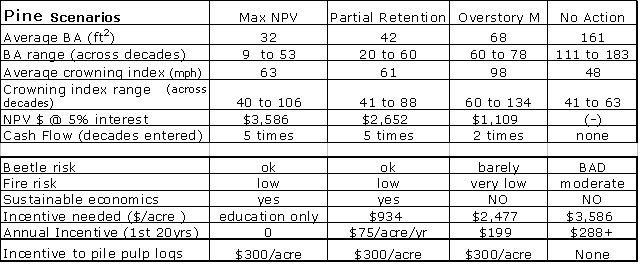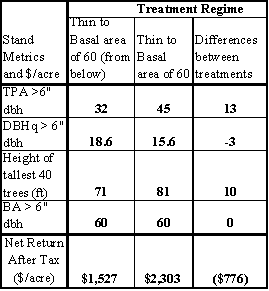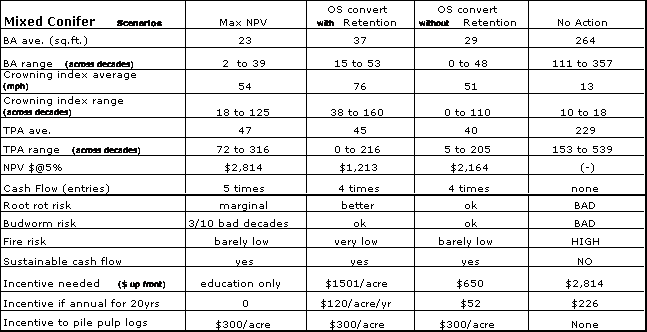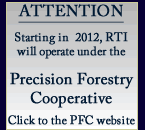Eastern
Washington forests are facing extreme pressure from stand
replacing fire and insect and disease outbreaks (RTI Factsheet
#31). The historic management approach over the last 100
years has favored continuous forest cover and ‘uneven-aged’ management
strategies combined with fire suppression. In all but the
driest forests, this management strategy has produced multi-layered
stands of shade-tolerant species on sites previously dominated
by single storied seral species. Fire suppression has homogenized
stand structure and species distributions at the larger landscape
level as well as increased the overall stocking and biomass
levels in the forest. These past management practices create
conditions suitable for extensive insect and disease epidemics
and high fire risk. Against this backdrop of legacies from
past management, it is necessary to overlay a complex pattern
of land ownership, a wide array of management goals, and
challenges in meeting those goals because of the lack of
infrastructure for removing excess fuel accumulations and
small diameter wood from the forest.
There are a number of
potential management strategies that can address forest health
issues in eastern Washington. The
success of any single treatment depends on the interplay
between biological condition, management goals, and economic
limitations.
To evaluate treatment alternatives, the Landscape Management
System (LMS), using the Forest Vegetation Simulator (FVS),
was used to simulate alternative treatments for meeting forest
health goals on two prevalent forest types: a ponderosa pine
type in the Okanogan area and a mixed conifer type in northeastern
Washington. The goal of the analysis was to assess the trade-offs
between economic return and reducing stand susceptibility
to insects, disease, and fire. For each alternative, we report
on the likelihood of risk reduction, economic outcomes, and
the subsequent level of incentive that might be needed to
encourage
landowners to adopt a specific treatment. Given the array
of management goals across the ownerships of eastern Washington,
there is no best single management alternative. Analyzing
alternatives
provides a useful comparison of trade-offs, costs, and expected
outcomes for meeting forest health goals.
In the ponderosa pine forest type, the stand used for our
analysis was a fully stocked merchantable ponderosa pine
stand that
is currently experiencing mountain pine beetle (MPB) mortality
because of excessive density and basal area relative to site
carrying capacity. On this very dry site, the ponderosa pine
is regenerating (albeit poorly) under its own shade, which
allows for treatment approaches that would not be as successful
on wetter sites. Table 1 gives the basal area, risk ratings
for fire and MPB, and economic values
over a 90-year simulation period. Periodic stand entries
were simulated using four different treatment regimes: (1)
Max NPV—maximizes
net present value of cash flows through removal of merchantable
volume to the limits permitted by state forest practices laws;
(2) Partial Retention—partial cutting from below to a
target basal area; (3) Overstory Maintenance—treatments
to move the stand toward ‘old growth’ conditions
with a few large trees/acre including understory removal; and
(4) No Action—a baseline assuming no disturbance.


| Table 1: Predicted mortality
risks and economic returns for a thinned ponderosa
pine stand under four treatment scenarios |
 |
Because both
Max NPV and Partial Retention emphasize initial overstory
retention to facilitate regeneration, initial treatments
can result in very similar residual stand conditions depending
on leave tree characteristics. As a result, both treatment
regimes can immediately move stands away from risky thresholds
for fire, insects, and disease. Future treatments that
facilitate the goals of each treatment regime do result
in widely disparate stand conditions and therefore variation
in resistance or resilience in the face of forest health
conditions over time. These biological outcomes suggest
that incentives for initial treatments to address forest
health need to focus on immediate biological gains without
requiring commitment to long term strategies that may not
meet the financial obligations of landowners. Table
1 indicates
that the discounted financial returns/acre for the three
treatments in ponderosa pine are positive, primarily because
the stand has a significant merchantable component. Reduced
returns from the Partial Retention treatments are a result
of retaining some large diameter overstory trees that would
otherwise have been removed in the Max NPV alternative.
Overstory Maintenance treatments are designed to produce
a widely spaced dominant pine stand akin to ‘old
growth’ conditions. Reduced returns from these treatments
are a function of lost revenue beyond the second entry
coupled with continuing financial obligations for understory
removal, either mechanically or by burning, to ensure that
the stand does not become overstocked and thus susceptible
to MPB attack and increasing fire risk. Incentives to facilitate
any particular management strategy are shown as the difference
between the maximum attainable value and the potential
returns under alternative scenarios. While the costs of
incentives are substantial, the possibility to amortize
these incentive payments over a 20 year annual period would
encourage a longer term management strategy to support
forest health needs in eastern Washington.


Further economic gains can be obtained in the Partial Retention
alternative relative to the Overstory Maintenance alternative
with judicious use of tree selection criteria. While treatments
such as controlling basal area to remain below the growth
basal area (GBA) of the stand help to reduce stand stress
(see factsheet
#31 for a discussion on GBA), operations that remove some
larger diameter trees can also effectively address forest
health and economic considerations. In the example ponderosa
pine stand, removing only trees <9” dbh results
in no appreciable basal area reduction and hence no forest
health benefit. Removing only trees < 12” dbh reduces
basal area to 90 ft2/acre, a value that exceeds the MPB threshold
for this site. Further reductions in basal area could occur
by continuing to thin from below or by selectively removing
a few larger diameter trees to increase the economic return
to the landowner. Comparisons of a thin from below treatment
that targets a basal area of 60 ft2/acre to a treatment that
thins >20” dbh trees combined with a thin from below
to the same target basal area results in the stand metrics
and economic outcomes given in Table 2.
Table 2: Stand attributes after treatment to address
forest health issues
 |
The differences in stand metrics between
the two treatments are relatively minor. However, the
differences in economic outcomes are significant. There
is nearly a $800/acre difference between treatments.
This differential implies that where financial considerations
are important, landowners may not choose to leave all
the largest trees while producing the attributes of
a healthy forest. The economic differentials also indicate
that almost half the value differential in net present
values between Partial Retention and Overstory Maintenance
can be attributable to tree selection criteria within
the first two treatment periods. As tree selection
criteria also drives long term forest health benefits,
maintaining more of the larger diameter trees within
these systems may require incentives to address immediate
economic needs. |
The economic viability of forest health restoration efforts
needs to consider the timing of stand treatments relative
to the stage of stand development. In our ponderosa pine
example, economic viability is largely determined by the
current state of the forest, as discounting favors returns
early in the simulation period. In the mixed conifer stand
example, the stand has been repeatedly harvested over the
past century using overstory removal techniques. The resulting
stand is composed of grand-fir, cedar and Douglas-fir that
are growing slowly because site conditions are not conducive
to rapid growth of these species. The stand is currently
barely merchantable, but within 40 years, a large component
of the intermediate cohort would become merchantable. Table
3 gives the stand metrics, risk ratings for fire,
insects and disease, and economic values over a 90-year simulation
period. Periodic stand entries were simulated using four
different treatment regimes: (1) Max NPV—removal
of merchantable volume at regular cutting cycles; (2) OS
with Retention—overstory conversion to a seral
species mix with retention of dominant Douglas-fir to provide
structural
diversity; (3) OS without Retention—no
retention of dominants (required wildlife trees in adjacent
riparian zones
are retained); and (4) No Action—assumes
no disturbances. The timing of forest health treatments in
these cases is
critical, as after the first entry, the investment required
for overstory conversion to forests with reduced fire and
root rot risk has to be amortized over a minimum of 40 years
prior to any returns. In this case, a status quo treatment
regime of continuing overstory removal maximizes NPV while
doing little to alleviate risks associated with fire, insects,
and disease.


| Table 3: Predicted mortality
risks and economic returns for a mixed conifer
stand under four treatment scenarios |
 |
While return
per acre in the species conversion scenarios continues
to improve through the simulation period, discounting at
5% negates the gains in later years. Table 3 also illustrates
the economic effect of retaining a minor number of large
trees into the next forest stand. Not only is the initial
value lost, but subsequent growth impacts reduce the value
of understory trees resulting in an additional 33% loss
in economic return over the 90 year period. In developing
incentives, the additional costs of retaining large diameter
structural elements in a species conversion scenario should
be quantified. With this cost accounting, a value can be
assigned to the structural elements that provide for key
non-market values using implicit market methods. This example
illustrates that incentives in mixed conifer forests must
be targeted to those stands that are at a developmental
stage that makes them well suited for conversion to species
that meet forest health criteria, whether it be addressing
fire, insect, or disease risks. Criteria for choosing stands
for forest health conversion incentives would include stands
that have at a minimum: few viable trees in the intermediate,
pole, and sapling categories; stagnated understory layers;
and limited ability to respond to overstory removal. Additional
criteria might include some component of seral, fire, or
disease resistant species in the overstory, though retention
of even a minor overstory component retards the growth
of understory species and hence reduces economic returns
in the long run.
Strategies to address forest health challenges can be developed
by considering site parameters and the multiple metrics
that describe stand dynamics. Forest health goals can best
be met with a flexible approach that permits landowners
to harvest sufficient numbers of larger trees to ensure
economic viability while maintaining basal area targets
and stand structures that promote forest health. Modest
incentive packages could be developed to target landowners
who would benefit the most by reducing forest health risk
and have costs that will likely be much smaller than the
public benefits of reducing fire, insect, and disease risk.
Similar analysis for a wider variety of stand types at
different stages of development will be required to determine
optimal strategies to achieve forest health objectives
across the wide range of conditions that exist within the
eastside landscape.

|







